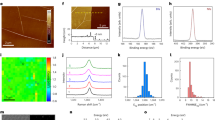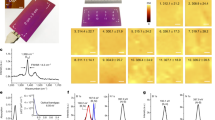Abstract
Hexagonal boron nitride (h-BN) has recently emerged as an excellent substrate for graphene nanodevices, owing to its atomically flat surface and its potential to engineer graphene’s electronic structure1,2. Thus far, graphene/h-BN heterostructures have been obtained only through a transfer process1, which introduces structural uncertainties due to the random stacking between graphene and h-BN substrate2,3. Here we report the epitaxial growth of single-domain graphene on h-BN by a plasma-assisted deposition method. Large-area graphene single crystals were successfully grown for the first time on h-BN with a fixed stacking orientation. A two-dimensional (2D) superlattice of trigonal moiré pattern was observed on graphene by atomic force microscopy. Extra sets of Dirac points are produced as a result of the trigonal superlattice potential and the quantum Hall effect is observed with the 2D-superlattice-related feature developed in the fan diagram of longitudinal and Hall resistance, and the Dirac fermion physics near the original Dirac point is unperturbed. The macroscopic epitaxial graphene is in principle limited only by the size of the h-BN substrate and our synthesis method is potentially applicable on other flat surfaces. Our growth approach could thus open new ways of graphene band engineering through epitaxy on different substrates.
This is a preview of subscription content, access via your institution
Access options
Subscribe to this journal
Receive 12 print issues and online access
$259.00 per year
only $21.58 per issue
Buy this article
- Purchase on Springer Link
- Instant access to full article PDF
Prices may be subject to local taxes which are calculated during checkout





Similar content being viewed by others
Change history
26 July 2013
In the version of this Letter originally published online, the year of the received date should have read '2012'. In Fig. 5, the numbers 10, 20, 8.5 and 17 on the colour scale bars should not have been followed by 'k'. These errors have been corrected in all versions of the Letter.
References
Dean, C. R. et al. Boron nitride substrates for high-quality graphene electronics. Nature Nanotech. 5, 722–726 (2010).
Xue, J. M. et al. Scanning tunneling microscopy and spectroscopy of ultra-flat graphene on hexagonal boron nitride. Nature Mater. 10, 282–285 (2011).
Yankowitz, M. et al. Emergence of superlattice Dirac points in graphene on hexagonal boron nitride. Nature Phys. 8, 382–386 (2012).
Dean, C. R. et al. Multicomponent fractional quantum Hall effect in graphene. Nature Phys. 7, 693–696 (2011).
Mayorov, A. S. et al. Micrometer-scale ballistic transport in encapsulated graphene at room temperature. Nano Lett. 11, 2396–2399 (2011).
Yu, Q. et al. Graphene segregated on Ni surfaces and transferred to insulators. Appl. Phys. Lett. 93, 113103 (2008).
Wofford, J. M. et al. Extraordinary epitaxial alignment of graphene islands on Au(111). New J. Phys. 14, 053008 (2012).
Sutter, P., Lahiri, J., Zahl, P., Wang, B. & Sutter, E. Scalable synthesis of uniform few-layer hexagonal boron nitride dielectric films. Nano Lett. 13, 276–281 (2012).
Ding, X. L., Ding, G. Q., Xie, X. M., Huang, F. Q. & Jiang, M. H. Direct growth of few layer graphene on hexagonal boron nitride by chemical vapor deposition. Carbon 49, 2522–2525 (2011).
Son, M., Lim, H., Hong, M. & Choi, H. C. Direct growth of graphene pad on exfoliated hexagonal boron nitride surface. Nanoscale 3, 3089–3093 (2011).
Tang, S. J. et al. Nucleation and growth of single crystal graphene on hexagonal boron nitride. Carbon 50, 329–331 (2012).
Zhang, L. C. et al. Vapour-phase graphene epitaxy at low temperatures. Nano Res. 5, 258–264 (2012).
Zhang, L. C. et al. Catalyst-free growth of nanographene film on various substrates. Nano Res. 4, 315–321 (2011).
Yang, W. et al. Characterization, and properties of nanographene. Small 8, 1429–1435 (2012).
Yang, R. et al. An anisotropic etching effect in the graphene basal plane. Adv. Mater. 22, 4014–4019 (2010).
Geick, R., Perry, C. H. & Rupprecht, G. Normal modes in hexagonal boron nitride. Phys. Rev. 146, 543–547 (1966).
Ferrari, A. C. et al. Raman spectrum of graphene and graphene layers. Phys. Rev. Lett. 97, 187401 (2006).
Malard, L. M., Pimenta, M. A., Dresselhaus, G. & Dresselhaus, M. S. Raman spectroscopy in graphene. Phys. Rep. 473, 51–87 (2009).
Dresselhaus, M. S., Jorio, A., Hofmann, M., Dresselhaus, G. & Saito, R. Perspectives on carbon nanotubes and graphene Raman spectroscopy. Nano Lett. 10, 751–758 (2010).
Shi, Z. W. et al. Patterning graphene with zigzag edges by self-aligned anisotropic etching. Adv. Mater. 23, 3061–3065 (2011).
Yang, R., Shi, Z. W., Zhang, L. C., Shi, D. X. & Zhang, G. Y. Observation of Raman G-Peak split for graphene nanoribbons with hydrogen-terminated zigzag edges. Nano Lett. 11, 4083–4088 (2011).
Koma, A. Van der Waals epitaxy for highly lattice-mismatched systems. J. Cryst. Growth 201–202, 236–241 (1999).
Altshuler, B. L., Aronov, A. G. & Lee, P. A. Interaction effects in disordered Fermi systems in two dimensions. Phys. Rev. Lett. 44, 1288–1291 (1980).
Park, C-H., Yang, L., Son, Y-W., Cohen, M. L. & Louie, S. G. Anisotropic behaviors of massless Dirac fermions in graphene under periodic potential. Nature Phys. 4, 213–217 (2008).
Park, C-H., Yang, L., Son, Y-W., Cohen, M. L. & Louie, S. G. New generation of massless Dirac fermions in graphene under external periodic potentials. Phys. Rev. Lett. 101, 126804 (2008).
Brey, L. & Fertig, H. A. Emerging zero modes for graphene in a periodic potential. Phys. Rev. Lett. 103, 046809 (2009).
Novoselov, K. S. et al. Two-dimensional gas of massless Dirac fermions in graphene. Nature 438, 197–200 (2005).
Zhang, Y. B., Tan, Y. W., Stormer, H. L. & Kim, P. Experimental observation of the quantum Hall effect and Berry’s phase in graphene. Nature 438, 201–204 (2005).
Gusynin, V. P. & Sharapov, S. G. Unconventional integer quantum hall effect in graphene. Phys. Rev. Lett. 95, 146801 (2005).
Novoselov, K. S. et al. Unconventional quantum Hall effect and Berry’s phase of 2π in bilayer graphene. Nature Phys. 2, 177–180 (2006).
Acknowledgements
The authors would like to thank H. Dai and F. Wang and Y. Yu for helpful discussions. G.Z. acknowledges supports from the 973 Program (2013CB934500 and 2012CB921302), the NSFC (91223204), and the ‘100 talents project’ of CAS. Y.Z. acknowledges supports from the 973 Program (2011CB921802) and NSFC (11034001). Y.Y. acknowledges supports from 973 Program (2011CBA00100) and NSFC (10974231, 11174337 and 11225418).
Author information
Authors and Affiliations
Contributions
G.Z. and Y.Z. designed the research; W.Y. performed the growth, structural characterization, device fabrication and electrical transport measurements; Z.S. helped with QHE measurements; G.C provided the h-BN substrates and helped with QHE measurements; K.W. and T.T. synthesized h-BN crystals; and C-C.L. carried out the band structure calculations. W.Y., G.C., Z.S., R.Y., D.S., Y.Y., Y.Z and G.Z. analysed data; W.Y., G.C., Y.Z. and G.Z. wrote, and all authors commented on, the manuscript.
Corresponding author
Ethics declarations
Competing interests
The authors declare no competing financial interests.
Supplementary information
Supplementary Information
Supplementary Information (PDF 1490 kb)
Rights and permissions
About this article
Cite this article
Yang, W., Chen, G., Shi, Z. et al. Epitaxial growth of single-domain graphene on hexagonal boron nitride. Nature Mater 12, 792–797 (2013). https://doi.org/10.1038/nmat3695
Received:
Accepted:
Published:
Issue Date:
DOI: https://doi.org/10.1038/nmat3695
This article is cited by
-
New methods to increase PVR in gate controllable armchair graphene-boron nitride RTDs
Optical and Quantum Electronics (2024)
-
Meta-GGA study of 2D AlN/BN planer heterostructure and performance enhancement via strain engineering
Journal of Molecular Modeling (2024)
-
From VIB- to VB-Group Transition Metal Disulfides: Structure Engineering Modulation for Superior Electromagnetic Wave Absorption
Nano-Micro Letters (2024)
-
Nonlinear optics of two-dimensional heterostructures
Frontiers of Physics (2024)
-
Research progress on heavy metals removal by graphene from wastewater
Carbon Letters (2024)



